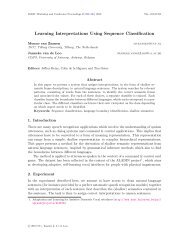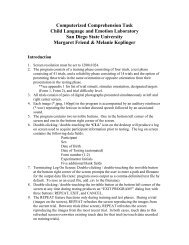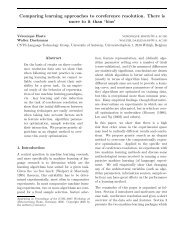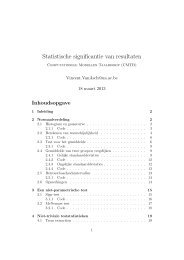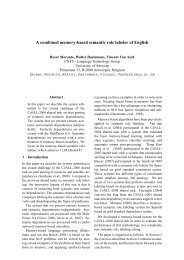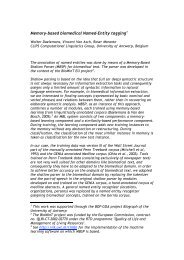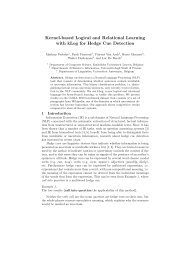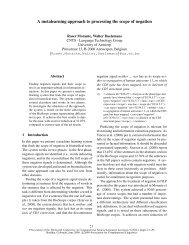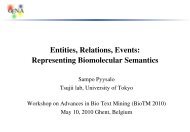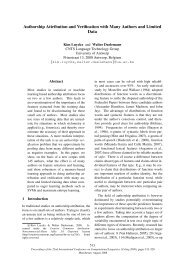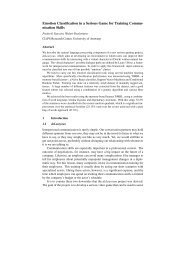Atila 2011 (Antwerp, 1-2 December) Schedule & Abstracts - CLiPS
Atila 2011 (Antwerp, 1-2 December) Schedule & Abstracts - CLiPS
Atila 2011 (Antwerp, 1-2 December) Schedule & Abstracts - CLiPS
You also want an ePaper? Increase the reach of your titles
YUMPU automatically turns print PDFs into web optimized ePapers that Google loves.
In this talk, we discuss the usability of this approach for emotion classification, andpresent the results.- Fine-grained emotion detection in suicide notes: Multi-label classification with probabilityestimates (Kim Luyckx, Frederik Vaassen, Claudia Peersman and Walter Daelemans)We present a system to automatically identify emotion-carrying sentences in suicide notesand to detect the specific fine-grained emotion conveyed. With this system, we competedin Track 2 of the <strong>2011</strong> Medical NLP Challenge (Pestian et al., <strong>2011</strong>), where the task was todistinguish between fifteen emotion labels, from guilt, sorrow, and hopelessness tohopefulness and happiness. An additional complication was the fact that half of thesentences was left unannotated, often not for lack of emotion, but for lack ofinterannotator agreement.Since the data set could contain multiple emotions per sentence, we adapted the system toenable assigning multiple emotion labels. The thresholding system devised to producemulti-label classification relies on probability estimates returned by an SVM classifier.Emotion labels are assigned only if their probability exceeds a certain threshold and if theprobability of the sentence being emotion-free is low enough. We show the advantages ofa thresholding approach by comparing it to a naïve system that assigns only the mostprobable label to each test sentence, and to a system trained on emotion-carryingsentences only.- Sentiment Analysis with Pattern 2 (Tom De Smedt and Walter Daelemans)The latest release of the Pattern web mining package for Python(http://www.clips.ua.ac.be/pages/pattern) contains a module for sentiment analysis forDutch and English adjectives. We present the new open source subjectivity lexicon forDutch adjectives. The lexicon is a dictionary of 1,100 adjectives that occur frequently inonline product reviews, manually annotated with polarity strength, subjectivity andintensity, for each word sense. We discuss two machine learning methods we used toautomatically expand the lexicon to 5,500 words. We evaluate the lexicon by comparing itto the user-given star rating of online product reviews. For Dutch book reviews, precisionis 0.77 and recall is 0.83.We demonstrate a current research project that applies the lexicon to Dutch politicalnewspaper articles.12.30-14.00: Lunch (in the Hyllit’s breakfast hall)14.00-15.00: Session 2 – Spelling (chair: Walter Daelemans, 3 talks)- Aligning divergent text versions with anagram hashing (Martin Reynaert)In the framework of the CLARIN-NL project VU-DNC we curate a diachronic corpus ofDutch newspaper texts. These have been annotated for subjectivity and quotations. The 1MW of 1950-1951 diachronic newsaper articles have been digitized by means of OpticalCharacter Recognition. The texts have been semi-manually corrected. As a subpart of ourcuration these ground truth texts are aligned with the noisy OCR-output to create goldstandards for OCR post-correction research.We describe a new token aligner designed to facilitate building OCR gold standards.Alignment is obtained by means of anagram hashing, which allows for numericalcomparison of the word strings in the ground truth versus the noisy OCR version. This2



